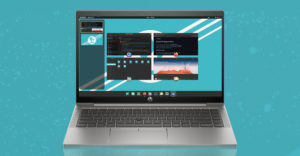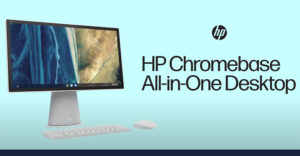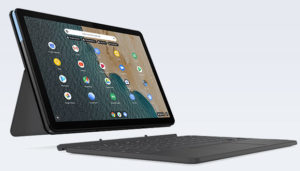Sometimes the world of smart technology innovations collides with the planet of dumb customer service provisions. That collision usually does not bode well for the customer.
In my case, that scenario is particularly true. I bought Lenovo’s Chromebook Duet 5 for an attractive price from a major national electronics store. In hindsight, that was a purchase I wish I could undo.
The Duet 5 is regarded in numerous reliable reviews as the best overall ChromeOS tablet/detachable computer available this year. Its larger screen and detachable full-size keyboard make a usable and fun tablet experience not available with pure Android devices.
For me, that accolade falls far short of reaching that mark. In fact, if your primary need for a Chromebook is to run Linux apps, think again about not buying Lenovo’s Duet 5. You might get a unit like mine that does not do Linux even though it is supposed to work. That failure is not considered a valid claim under Lenovo’s warranty.
I have become quite fond of Chromebooks. ChromeOS devices supplement my home office cadre of Linux computers. They link to my Android phone and its apps. I can run the same productivity apps and access their data directly on the Chromebook.
What fed my attraction to the Duet 5 is its logical follow-up to the very popular 10.1″ original Duet I bought a few years ago. The Duet line has a detachable keyboard and is a stand-alone ChromeOS tablet.
Putting want versus need aside, I debated the prospect of more productivity and convenience with a bigger screen at 400 nits, larger keyboard, and 8GB of RAM. I knew the manufacturer and the retail store as well as the product line. Or so I thought.
What could go wrong? Three things: a failed product, no support, and a warranty that also did not work!
Maybe One Too Many
The last thing I needed to buy was yet another Chromebook. Over the last few years, I have used four or five models from HP, Lenovo, and Asus.
The Duet 5 seemed to check all the boxes. As it turned out, the check mark fell out of the box for reliable tech support and customer service.
Nope, I could not return the computer. By the time I discovered its defective nature the undo window had closed.
I suppose this incident will nudge me to buy expensive add-on store warranties for less expensive electronic devices. Adding insult to injury, Lenovo tech support said the malfunction was “beyond the scope of the manufacturer’s one-year warranty.”
A final correspondence from Lenovo’s tech support told me that if I shipped the device to its repair facility, all the technicians would do is reset the unit to its original OS status and remove Linux.
Heck, I had already done the same thing twice.
Lenovo Buyers Beware
This account is not intended to be a product review. Rather, it tells what happens when corporate arrogance destroys the customer experience.
I usually write about business technology issues and open-source developments impacting the Linux OS. My reporting beat overlaps with e-commerce and customer relationship management (CRM) issues.
As a tech writer and product reviewer, I am used to manufacturers sending me top-of-their-line products in hopes of showing off their best wares. Marketing marvels often offer high-end configurations to curry consumers’ attention. They go out of their way to make sure the reviewer is fully satisfied.
Too bad that mentality does not always exist when lowly consumers are on the receiving end. But I was not using a loaner unit I would send back anyway, satisfied or not. I bought this model with no plans to review it. I just wanted to use it.
My personal experience hardened my resolve to not buy a Lenovo product going forward. Not because of a bad product encounter. Lenovo lost my customer loyalty because of shoddy customer service and no dedication to resolving my issue with a malfunctioning computer that they built.
The Gory Details
According to Lenovo’s ill-conceived logic, the warranty on Chromebooks does not cover user modifications. Since I activated the Linux partition, ran into a problem, removed the partition, and reinstalled Linux apps not there when I bought it, I was guilty of modifying the device.
To clarify, all Chromebooks require the user to turn on the Linux partition and install Linux apps. That is the same process for using Android apps on Chromebooks.
Chromebooks are built to run the ChromeOS and optionally to run in separate built-in containers Android and Linux software. Google certifies the hardware to ensure the software works.
The ChromeOS similarly enables users to access websites in a browser environment. An added option lets users access those web destinations to run application services within tabbed browser windows or as progressive web apps (PWAs) in their own isolated windows.
That is what Chromebooks are designed to do on any manufacturer’s hardware. Turning these built-in features on/off should not be construed as “modifying” the device.
Tech Support Hell
A few weeks after receiving the Duet 5, I experienced only an intermittent screen flickering issue. That cleared up after a system update. No worries. No concerns.
At that point I turned on the Linux partition and installed the same Linux apps that I use on my other lesser-endowed Chromebooks. Those devices worked fine with the same apps installed.
But the Lenovo Duet 5 froze after loading the Linux apps and running for a few minutes. Glitchy installations happen. So I did what is standard troubleshooting. I reset the ChromeOS to its original status. I then set up the Linux partition and sized it well beyond the Google-recommended minimum size.
Problem NOT solved. So I wiped the Linux partition again. This time, I installed a single Linux app one at a time looking for the culprit throwing the others out of whack. Every Linux app in isolation froze.
Lenovo tech support declined to investigate or test the hardware. The agents suggested finding an affiliated tech center to pursue a solution.
Stuck With No Options
I gladly would have done that. But the nearest such Lenovo repair center was across state lines some 150 miles away.
I reached out to the Google Chromebook support community for an alternative solution. A support person there had me run the “df command” in a Linux terminal to determine the physical health of the partition.
The readout from that diagnostic confirmed the device has a valid and working Linux container. That partially settled the question about the hardware. It did not, however, identify what other hardware issues might be involved.
The Google support forum tech then suggested I look for one or more dud packages by following the procedure outlined above. But, of course, I already did that several times.
Lousy Lessons Learned
If you plan to buy a Chromebook just to have easy access to selected Linux apps, seriously consider my experience. Maybe look elsewhere instead of the Duet 5. Numerous Chromebook alternatives exist.
Who knows? Maybe the Linux apps will work fine for you on your Duet 5. As I said, I have not had this situation on any other Chromebook product I use.
No doubt my experience was a gross anomaly. The aggravating part in all of this is that I will never know the cause.
But if you buy a Duet 5 from a retail outlet instead of directly from the manufacturer, be sure to confirm how that store honors the warranty. You now know how Lenovo honors its warranty.
















































